Quentin Tarantino shot there. So did Clint Eastwood, Steve McQueen, Kevin Costner and John Wayne. Robert Downey Jr. went on location there as the Iron Man. Whenever Hollywood is looking for a distant planet, or the long-gone Old West, or a rugged outdoors landscape for a Dodge Ram Tough truck commercial, there is one go-to location: Alabama Hills.
The Alabama Hills are not, as you might think, in Birmingham or Mobile. Rather, they are in California at the foot of Mount Whitney, at 14,500-feet above sea level the tallest mountain in the continental United States. Whitney and other mighty peaks in the Eastern Sierra form an awe-inspiring backdrop to the Alabama Hills that cannot be matched, even by the wizards of CGI.
Hollywood Meets Lone Pine
Moviemakers have been coming to the Alabama Hills since before the movies had sound. It is about a four-hour drive from Hollywood to Lone Pine, the small Highway 395 town that serves as the gateway to the hills. Since 1920, when the rotund silent screen comedian Fatty Arbuckle starred in “The Round-Up,” some 300 movies have been made there. Also hundreds of episodes of “The Lone Ranger,” “Rawhide,” “Maverick” and other TV shows, as well as Marlboro Man and countless other commercials.
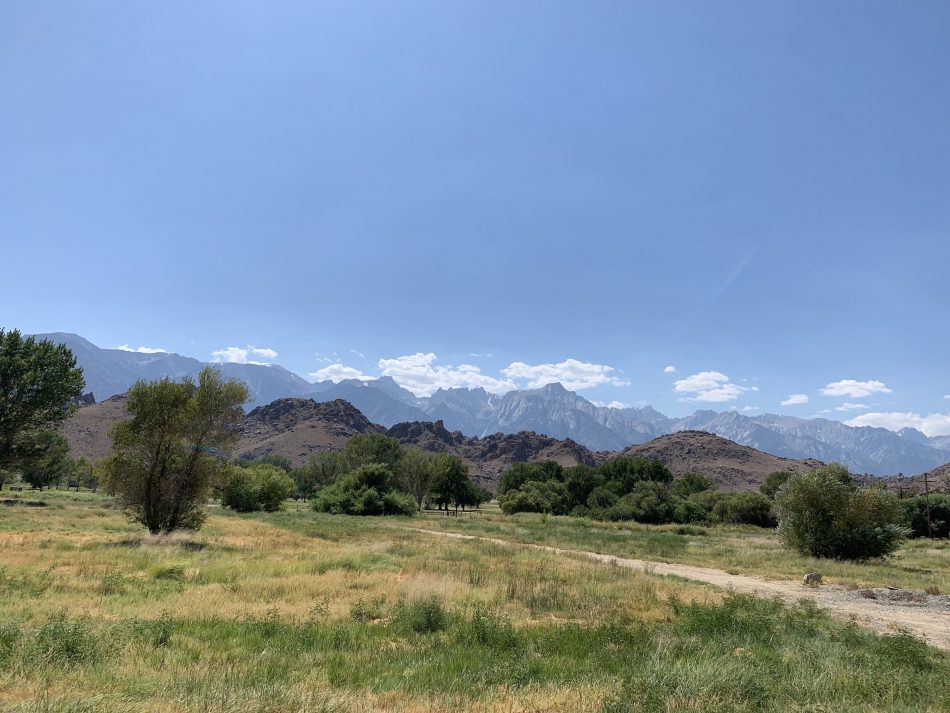
The Alabama Hills consist of 30,000 acres of public lands managed by the U.S. Bureau of Land Management. Although it is indeed a sprawling landscape of hills, the site might just as easily be referred to as the “Alabama Rocks.” Outcroppings of gray and brown weather-beaten granite boulders are scattered across a dry, dusty landscape whose major vegetation appears to be, appropriately, sagebrush. Millions of years of erosion have formed the unusual jagged rounded shapes of the rocks. Its most photographed rock formation is the Mobius Arch. Through the opening in the natural arch one can see the proud distinctive face of Whitney.
Rough and Tumble Landscape
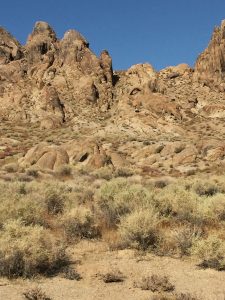 On a visit there it is easy to see the place’s rough and tumble cinematic appeal, particularly for Westerns. Drive a few miles west of Lone Pine on Whitney Portal Road, turn right on Movie Road, a dusty dirt road, and you will find yourself in a giant real-life Western movie set. Tom Mix, Hopalong Cassidy, Gene Autry, Audie Murphy, Roy Rogers and Dale Evans were among the old-time cowboy stars to make films and TV shows there. Some of the best and most popular westerns ever made, including “Ride the Wild Country” directed by Sam Peckinpah and starring Randolph Scott, shot scenes in the hills.
On a visit there it is easy to see the place’s rough and tumble cinematic appeal, particularly for Westerns. Drive a few miles west of Lone Pine on Whitney Portal Road, turn right on Movie Road, a dusty dirt road, and you will find yourself in a giant real-life Western movie set. Tom Mix, Hopalong Cassidy, Gene Autry, Audie Murphy, Roy Rogers and Dale Evans were among the old-time cowboy stars to make films and TV shows there. Some of the best and most popular westerns ever made, including “Ride the Wild Country” directed by Sam Peckinpah and starring Randolph Scott, shot scenes in the hills.
One place to stop is Lone Ranger Canyon; another is where they filmed “How the West Was Won.” For the 1972 Clint Eastwood western “Joe Kidd,” the opening credits roll over some men riding horseback across the hills with the Sierra rising grandly in the background. The high desert landscape is like a compelling character in the film, impossible to ignore. You can’t take your eyes off it when it appears.
Tarantino Comes to Town

The popularity of westerns faded in the 1950s and early ‘60s when audience tastes began to favor more urban dramas and settings. Even so, Quentin Tarantino’s 2012 revisionist western, “Django Unchained,” starring Jamie Foxx and Leonardo DiCaprio, filmed there. Tarantino donated a signed script, his director’s chair and the dentist’s wagon featured in the movie to the Museum of Western Film History in Lone Pine, a mandatory stop for all film buffs traveling to the hills. It is a charming museum that houses a very fine collection of Western movie memorabilia including costumes, posters, props and an old-time camera car driven ahead of the horses and riders during action sequences. A short documentary in the museum’s theatre provides an entertaining look at the film history of the Alabama Hills, and every year in October it hosts a film festival.
Other types of movies are shot in the hills as well, ones having nothing to do with the old West. These include “Iron Man,” “Superman,” “Gladiator,” two of the “Star Trek” movies, “Transformer 2,” and “Tremors.” In the original “Tremors,” released in 1990 and starring Kevin Bacon, a strange creature known as the Graboid kills people by pulling them into its underground lair. The Graboid now lives above ground in the museum, although a note next to the display says that the creature is only on loan. If the filmmakers ever want it back for a future movie, it is theirs for the taking. The cult movie hit spawned several sequels and almost a television series that was cancelled before production.
Whitney Portal
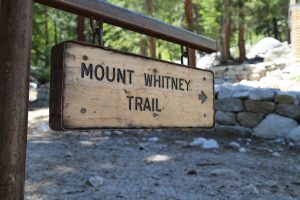 No trip to the Alabama Hills would be complete without a drive up to the Whitney Portal at the eastern base of Mount Whitney. Even if you do not plan to do any hiking, it is worth seeing. It is 13 miles from Lone Pine, up a curving mountain road that ends in much cooler habitat than what you will find down below. When we went there, in late August, the temperature at the Portal was about 73 degrees compared to 95 in Lone Pine.
No trip to the Alabama Hills would be complete without a drive up to the Whitney Portal at the eastern base of Mount Whitney. Even if you do not plan to do any hiking, it is worth seeing. It is 13 miles from Lone Pine, up a curving mountain road that ends in much cooler habitat than what you will find down below. When we went there, in late August, the temperature at the Portal was about 73 degrees compared to 95 in Lone Pine.
The Portal is a jumping off point for those who are about to climb the peak, and an end point for those who have done it. When we were there, late in the afternoon, we saw a group of scruffy, tired-looking hikers coming down the trail. They had either climbed part way up the mountain and come back down, or possibly done the whole thing in a single day. People can and do summit the peak in a day, although the roughly 22-mile round trip is not to be undertaken lightly.
The portal has a grocery store and campgrounds. One surprise we happened upon near the parking lot was a cascading waterfall, still engaged in its rollicking dance down the mountain despite the lateness of the season.

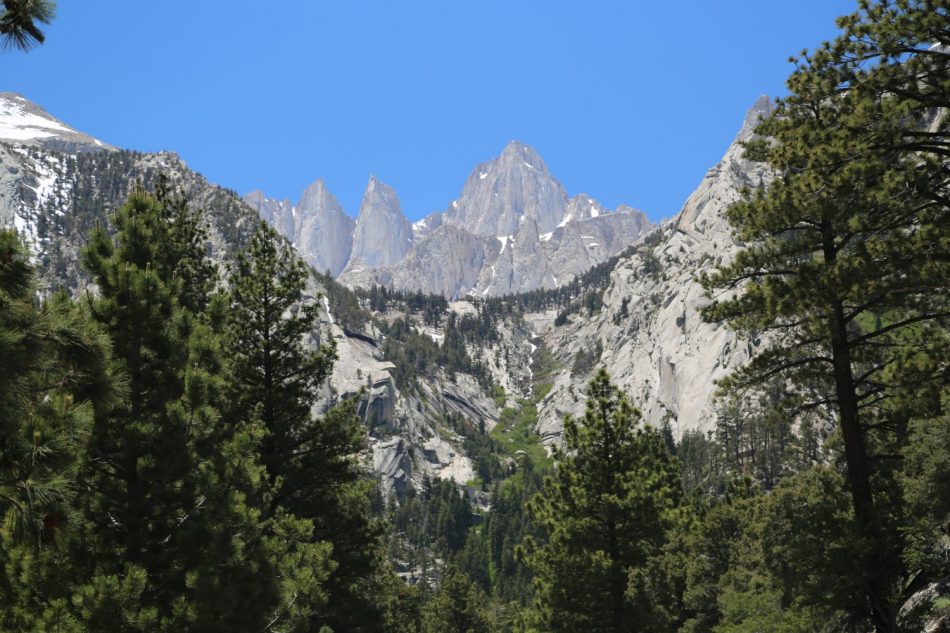
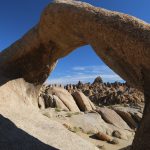

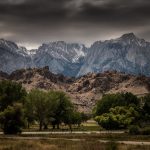


Favorite part of the state 🙂